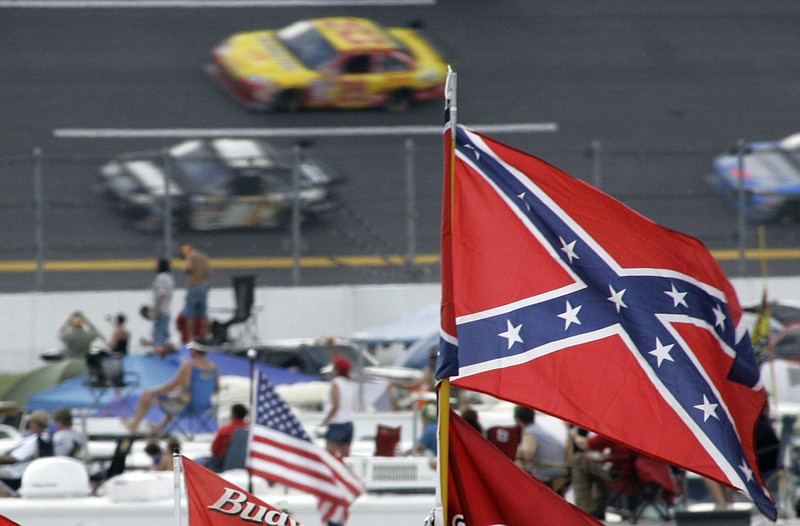Fifty years ago today, the United States Supreme Court ruled on a case dealing with the right of a Chattanooga student to wear a Confederate emblem on his jacket, and that ruling seems to have been a precedent for subsequent court rulings on similar matters.
By refusing to hear the case, the high court upheld the decision from the 6th U.S. Circuit Court of Appeals, which said Brainerd High School Principal Billy von Schaaf had been correct in asking senior student Rod Melton not to wear the emblem because it had become too provocative during the integration of the school.
Racial tensions had roiled the school during the 1969-1970 school year, prompting it to close several times, and a biracial committee formed afterward recommended that the Confederate flag as a school symbol and "Dixie" as the school pep song be dropped.
Melton wore the jacket to school in the fall of 1970, and von Schaaf asked him to remove the emblem or stop wearing the jacket. When he wore it again the next day, he was told to remove the jacket or leave school. He left school, and eventually his parents brought suit in federal court.
The 1971 ruling by U.S. District Judge Frank Wilson maintained that "the principal had every right to anticipate that a tense racial situation continued to exist at Brainerd High School ... in September of 1970 and that repetition of the previous year's disorder might reoccur if student use of the Confederate symbol was permitted to resume."
The Court of Appeals later upheld Wilson's decision, saying the principal had the right to make the decision he did.
In a number of cases this century, the Supreme Court has taken a similar route, dismissing or refusing to hear the case and letting lower court bans on Confederate apparel in schools stand.
› In 2013, the 4th U.S. Circuit Court of Appeals ruled that public school officials in Latta, South Carolina, did not violate the First Amendment rights of a public school student who was asked to remove or cover up the Confederate flag on her T-shirts. The student said her First Amendment rights had been violated, but school officials countered that the Confederate flag was a disruptive symbol in a school that had had instances of race-based tension.
› In 2009, the high court dismissed the case of students at William Blount High School in Maryville, Tennessee, who said their free speech rights had been taken away by a 2005 policy decision to ban images of the Confederate flag at the school. In rejecting the case, it left in place the decision by the U.S. 6th Circuit Court of Appeals which maintained the policy was legal because school officials could reasonably forecast that images of the flag would "substantially and materially disrupt the school environment."
› In 2009, the 8th U.S. Circuit Court of Appeals affirmed a U.S. District Court ruling that school officials in Farmington, Missouri, were justified in suspending students for wearing Confederate flag clothing. Before the 2006-2007 school year incidents, the local school district had established a dress-code policy that prohibited apparel "that materially disrupts the education educational environment" and subsequently barred Confederate flags and symbols.
› In 2000, West v. Derby Unified School District 260, the 10th U.S. Circuit Court of Appeals found that suspending a Kansas student for drawing a Confederate flag and showing it to other students, even if he had no intent to "harass or intimidate," did not violate the First Amendment or equal protection because it was disruptive to the learning environment.
The online First Amendment Encyclopedia, a work of the John Seigenthaler Chair of Excellence in First Amendment Studies at Middle Tennessee State University, characterized the Chattanooga case as "one of the early times an appeals court had to grapple with the troubling question of regulating Confederate flag clothing in public schools."
In actual fact, symbols of the Confederate flag are not banned in schools, but, as the numerous courts above have ruled, they can be if they are found to be a disruption. The Supreme Court set that precedent in Tinker v. Des Moines in a case that did not involve Confederate symbols but black arm bands protesting the then-Vietnam war.
"Clearly, the prohibition of expression of one particular opinion, at least without evidence that it is necessary to avoid material and substantial interference with schoolwork or discipline, is not constitutionally permissible," the justices wrote.
In the Chattanooga case, though, in perhaps a first time involving Confederate symbols, the court found the "material and substantial interference" was present and ruled against Melton, who was, by all reports, an otherwise quiet and excellent student.
Today, in a polarized country where people look for ways to be offended and within the supercharged atmosphere of public schools, it would be difficult to find any situation in which the "expression of one particular opinion" would not cause "material and substantial interference with schoolwork or discipline" in the eyes of someone.
